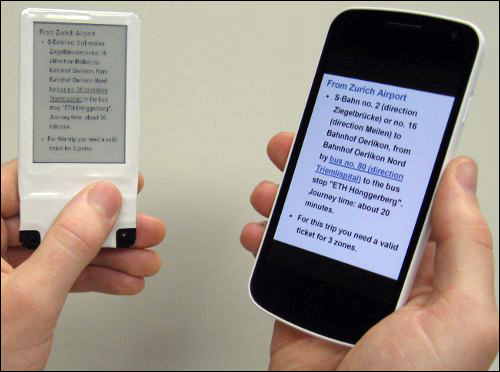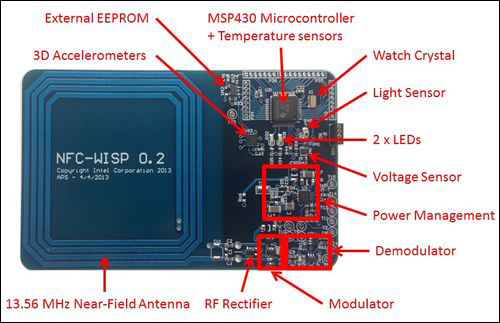A group of researchers from Intel Labs, in Oregon, as well as several universities, have partnered to develop a power-harvesting Near Field Communication (NFC) tag that can store sensor data and display it on an electronic paper (e-paper) screen, by using power harvested from a user’s NFC-enabled mobile smartphone during tag reads. The technology, known as the NFC Wireless Identification and Sensing Platform (NFC-WISP), could become open for use by developers by December 2013, says Alanson Sample, the Intel Labs research scientist and principal investigator who led the technology’s development. Sample envisions the Wirelessly Powered Bistable Display Tag—a version of the NFC-WISP tag that includes an e-paper display—to track sensor measurements and display that information on its screen, or to store and display data from an NFC-enabled phone, such as a map, credit card or airplane boarding pass. The energy to power the processor, sensors and display, he says, is harvested from each NFC read event.
The NFC-WISP technology was developed by a team of researchers and students from the University of Washington and the University of Massachusetts, Amherst, as well as Sample and other Intel researchers.

Intel researchers and the University of Washington created an ultrahigh-frequency (UHF) version of the technology in 2009 (see Intel, University Researchers Develop Power-Storing Passive Tags). The research team built 500 of the UHF power-harvesting tags—which collect energy from ambient radio frequency signals—and distributed them to other university researchers and software developers, enabling them to develop their own solutions using the tag. That work continues, Sample says, such as the development of a UHF RFID tag that illuminates a built-in light-emitting diode (LED) upon sensing an RFID reader in its vicinity (to help robots identify an item, for example). Developers are also working on a system by which the tags would be used to identify when objects within a home are moved (based on motion-sensor data), to help health-care personnel understand activities of a patient alone at home.
Sample, who completed his post-doctoral work at the University of Washington last year and was a participant in the UHF WISP tag’s development, says he felt a high-frequency (HF) NFC version would help expand the technology’s applications, and he thus launched the NFC-WISP project at Intel. NFC, he states, “would serve a different purpose than UHF.” While UHF tags have long read ranges, he explains, they require a user to acquire fixed or handheld readers in order for them to be of any value. Offering an NFC version of the technology, he says, could open up use cases to include NFC-enabled Android phones.
The resulting NFC-WISP device is a software-defined 13.56 MHz RFID tag with an onboard Texas Instruments MSP320 microcontroller handling all bi-directional communication, as well as user-defined sensing and computational tasks. Since the NFC communication protocol is implemented in firmware on the MSP430, it can be programmed to utilize different protocols, such as those compliant with the ISO 15693 and ISO 14443 standards, or researchers can opt to implement proprietary or other protocols. These different protocols will allow developers greater flexibility in creating additional functions, such as cryptography, to ensure the security of tag data, for example. The tag also comes with sensors, such as a 3D accelerometer, light and temperature sensors, and a rectified voltage measurement circuit. In addition, it has a Maxim Integrated harvester chip to collect energy received from a reader transmission, along with a rechargeable lithium Thinergy battery supplied by Infinite Power Solutions. The technology is designed to allow researchers to create their own NFC RFID applications using NFC-enabled smartphones and RFID readers.
The Wirelessly Powered Bistable Display Tag measures 100 millimeters by 50 millimeters (3.9 inches by 2 inches), with a thickness of approximately 3 millimeters (0.1 inch). The tag includes the NFC-WISP hardware, as well as a 2.7-inch black-and-white e-paper display. This display draws its power from the microchip that captures and then stores energy from an NFC reader’s RF signals during a read transaction. With each read event, the phone radiates about 200 milliwatts of power, of which 17.7 mW is harvested by the display tag when the phone and tag come within 5 centimeters (2 inches) of each other. During testing, the researchers found that the prototype tag could transfer a 5.67-kilobyte image from the phone to the tag in about 3.4 seconds, while compressing the file would make the transmission time shorter.
The researchers also developed an Android smartphone application that instructs the smartphone to take a screenshot of its own display if the phone is shaken, and to use its built-in NFC reader to transmit that image to the e-paper tag as soon as the tag is detected within the 5-centimeter read range. This app converts the phone screenshot to a black-and-white image appropriate in size and structure for the e-paper display screen.
The e-paper NFC-WISP tag could be installed at a location such as a cooler where perishable foods may be stored, for example, in a supermarket. Powered by energy stored on its rechargeable battery, the tag would collect temperature data at a pre-determined rate and store it in 2 megabits (0.25 megabyte) of memory. Later, an employee could utilize a mobile phone to capture that data and forward it to a server for future analytics. While doing so, the phone would recharge the tag. For additional recharging, the phone would need to be held against the tag for a longer span of time. The battery used in the prototype version, Sample notes, takes approximately 15 minutes to charge to 90 percent capacity.

If the tag is not being frequently interrogated, it could also be programmed to display the temperature data on the e-paper, and to update that display every time a new sensor reading was taken. The more often this occurred, the more battery power would be consumed, so recharging would become necessary more often—perhaps daily, for example, rather than several times a week.
In another scenario, the tag could be used as a companion display to a smartphone. Users could access a Web site on a phone and transmit an image of that site to the tag, which would then display the page on its own screen, thereby conserving the phone’s battery consumption. In that way, the screen could preserve information on a phone’s main display and allow the phone itself to be placed in a sleep state. The tag could potentially store up to 200 images, each averaging 6 kilobits in size. Data to be displayed could include an individual’s boarding pass or credit card information, all stored on the single tag.
The NFC-WISP technology is designed to allow researchers to explore various applications using NFC technology, Sample says. “We’re still just starting to think about the possibilities,” he states. Currently, the display tags cost about $100 apiece when produced in a batch of five, though high volume and further development of the hardware could make them much less expensive, he notes.


